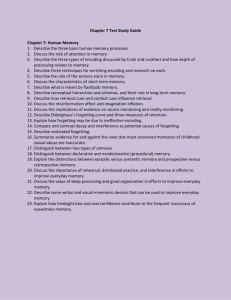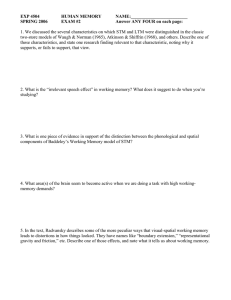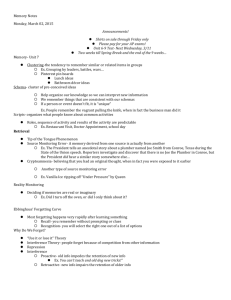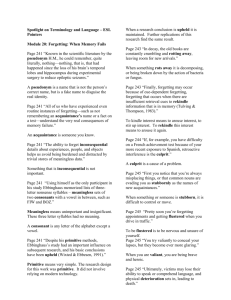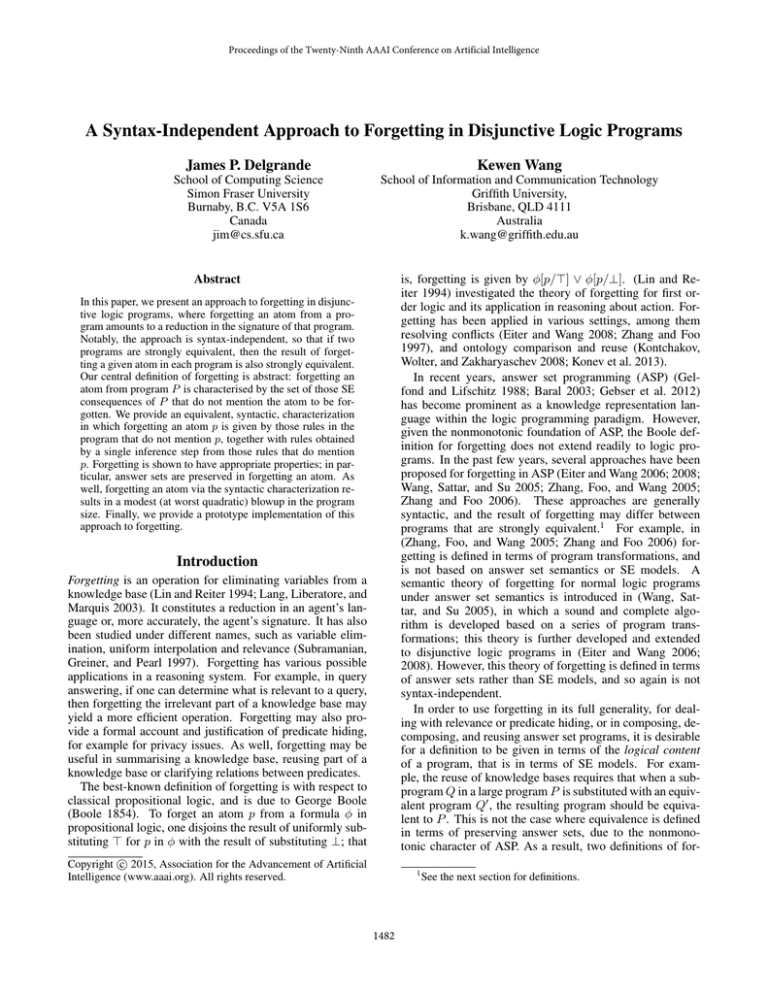
Proceedings of the Twenty-Ninth AAAI Conference on Artificial Intelligence
A Syntax-Independent Approach to Forgetting in Disjunctive Logic Programs
James P. Delgrande
Kewen Wang
School of Computing Science
Simon Fraser University
Burnaby, B.C. V5A 1S6
Canada
jim@cs.sfu.ca
School of Information and Communication Technology
Griffith University,
Brisbane, QLD 4111
Australia
k.wang@griffith.edu.au
is, forgetting is given by φ[p/>] ∨ φ[p/⊥]. (Lin and Reiter 1994) investigated the theory of forgetting for first order logic and its application in reasoning about action. Forgetting has been applied in various settings, among them
resolving conflicts (Eiter and Wang 2008; Zhang and Foo
1997), and ontology comparison and reuse (Kontchakov,
Wolter, and Zakharyaschev 2008; Konev et al. 2013).
In recent years, answer set programming (ASP) (Gelfond and Lifschitz 1988; Baral 2003; Gebser et al. 2012)
has become prominent as a knowledge representation language within the logic programming paradigm. However,
given the nonmonotonic foundation of ASP, the Boole definition for forgetting does not extend readily to logic programs. In the past few years, several approaches have been
proposed for forgetting in ASP (Eiter and Wang 2006; 2008;
Wang, Sattar, and Su 2005; Zhang, Foo, and Wang 2005;
Zhang and Foo 2006). These approaches are generally
syntactic, and the result of forgetting may differ between
programs that are strongly equivalent.1 For example, in
(Zhang, Foo, and Wang 2005; Zhang and Foo 2006) forgetting is defined in terms of program transformations, and
is not based on answer set semantics or SE models. A
semantic theory of forgetting for normal logic programs
under answer set semantics is introduced in (Wang, Sattar, and Su 2005), in which a sound and complete algorithm is developed based on a series of program transformations; this theory is further developed and extended
to disjunctive logic programs in (Eiter and Wang 2006;
2008). However, this theory of forgetting is defined in terms
of answer sets rather than SE models, and so again is not
syntax-independent.
In order to use forgetting in its full generality, for dealing with relevance or predicate hiding, or in composing, decomposing, and reusing answer set programs, it is desirable
for a definition to be given in terms of the logical content
of a program, that is in terms of SE models. For example, the reuse of knowledge bases requires that when a subprogram Q in a large program P is substituted with an equivalent program Q0 , the resulting program should be equivalent to P . This is not the case where equivalence is defined
in terms of preserving answer sets, due to the nonmonotonic character of ASP. As a result, two definitions of for-
Abstract
In this paper, we present an approach to forgetting in disjunctive logic programs, where forgetting an atom from a program amounts to a reduction in the signature of that program.
Notably, the approach is syntax-independent, so that if two
programs are strongly equivalent, then the result of forgetting a given atom in each program is also strongly equivalent.
Our central definition of forgetting is abstract: forgetting an
atom from program P is characterised by the set of those SE
consequences of P that do not mention the atom to be forgotten. We provide an equivalent, syntactic, characterization
in which forgetting an atom p is given by those rules in the
program that do not mention p, together with rules obtained
by a single inference step from those rules that do mention
p. Forgetting is shown to have appropriate properties; in particular, answer sets are preserved in forgetting an atom. As
well, forgetting an atom via the syntactic characterization results in a modest (at worst quadratic) blowup in the program
size. Finally, we provide a prototype implementation of this
approach to forgetting.
Introduction
Forgetting is an operation for eliminating variables from a
knowledge base (Lin and Reiter 1994; Lang, Liberatore, and
Marquis 2003). It constitutes a reduction in an agent’s language or, more accurately, the agent’s signature. It has also
been studied under different names, such as variable elimination, uniform interpolation and relevance (Subramanian,
Greiner, and Pearl 1997). Forgetting has various possible
applications in a reasoning system. For example, in query
answering, if one can determine what is relevant to a query,
then forgetting the irrelevant part of a knowledge base may
yield a more efficient operation. Forgetting may also provide a formal account and justification of predicate hiding,
for example for privacy issues. As well, forgetting may be
useful in summarising a knowledge base, reusing part of a
knowledge base or clarifying relations between predicates.
The best-known definition of forgetting is with respect to
classical propositional logic, and is due to George Boole
(Boole 1854). To forget an atom p from a formula φ in
propositional logic, one disjoins the result of uniformly substituting > for p in φ with the result of substituting ⊥; that
c 2015, Association for the Advancement of Artificial
Copyright Intelligence (www.aaai.org). All rights reserved.
1
1482
See the next section for definitions.
For simplicity, we sometimes use a set-based notation, expressing a rule as in (1) as
getting have been introduced in HT-logic (Wang et al. 2012;
Wang, Wang, and Zhang 2013). These approaches indirectly establish theories of forgetting under SE models, as
HT-logic provides a natural extension of SE models. The
approach to interpolation for equilibrium logic introduced
in (Gabbay, Pearce, and Valverde 2011) is more general than
forgetting. However, the issue of directly establishing a theory of forgetting for disjunctive logic programs under SE
models is still missing, and the issue of developing efficient
algorithms for computing the result of forgetting under SE
models is not addressed.
A key intuition regarding forgetting is that the logical consequences of a set of formulas that do not mention forgotten symbols should still be believed after forgetting. This
leads to a very simple (abstract) knowledge-level definition
in terms of a consequence operator in the underlying logic:
forgetting a symbol from a knowledge base is characterised
by the set of consequences that do not mention that symbol.
In this paper, we establish such a theory of forgetting for disjunctive logic programs that preserves strong equivalence.
In the next section we give a brief introduction to ASP,
with emphasis on the notion of SE models and on the notion
of SE consequence. The following section gives a high-level
abstract characterisation of forgetting in ASP, and shows
that it has the appropriate properties (for example, that it
is indeed syntax-independent, and that forgetting a set of
atoms is independent of the order of forgetting the individual atoms). We then give an equivalent syntactic characterisation of forgetting, and we show that forgetting an atom results in at worst a quadratic blowup in the size of the knowledge base. This also immediately leads to an algorithm for
computing forgetting under SE models. We investigate some
optimisation techniques for the algorithm and report a prototype implementation of the algorithm. Last, we compare
our approach to related work, and briefly conclude.
H(r) ← B(r)+ , ∼B(r)− .
The reduct of a program P with respect to a set of atoms Y ,
denoted P Y , is the set of rules:
{H(r) ← B(r)+ | r ∈ P, B(r)− ∩ Y = ∅}.
Note that the reduct consists of negation-free rules only. An
answer set Y of a program P is a subset-minimal model of
P Y . A program induces 0, 1, or more answer sets. The
set of all answer sets of a program P is denoted by AS (P ).
For example, the program P = {a ←, c; d ← a, ∼b}
has answer sets AS (P ) = {{a, c}, {a, d}}. Notably, a program is nonmonotonic with respect to its answer sets. For
example, the program {q ← ∼p} has answer set {q} while
{q ← ∼p, p ←} has answer set {p}.
SE Models
As defined by (Turner 2003), an SE interpretation is a pair
(X, Y ) of interpretations such that X ⊆ Y ⊆ A. An SE
interpretation is an SE model of a program P if Y |= P and
X |= P Y , where |= is the relation of logical entailment in
classical logic. The set of all SE models of a program P
is denoted by SE (P ); this notation extends in the obvious
fashion to the set of SE models for a given alphabet, viz.
SE (A). Then, Y is an answer set of P iff (Y, Y ) ∈ SE (P )
and no (X, Y ) ∈ SE (P ) with X ⊂ Y exists.
Program P is satisfiable just if SE (P ) 6= ∅.2 Thus, we
consider P = {p ← ∼p} to be satisfiable, since SE (P ) 6= ∅
even though AS (P ) = ∅. Programs P and Q are strongly
equivalent, symbolically P ≡s Q, iff SE (P ) = SE (Q).
Alternatively, P ≡s Q holds iff AS (P ∪ R) = AS (Q ∪ R),
for every program R (Lifschitz, Pearce, and Valverde 2001).
We also write P |=s Q iff SE (P ) ⊆ SE (Q).
Answer Set Programming
SE Consequence
Here we briefly review pertinent concepts in answer set
programming; for details see (Gelfond and Lifschitz 1988;
Baral 2003; Gebser et al. 2012).
Let A be an alphabet, consisting of a set of atoms. A
(disjunctive) logic program over A is a finite set of rules of
the form
a1 ; . . . ; am ← b1 , . . . , bn , ∼c1 , · · · , ∼cp .
While the notion of SE models puts ASP on a monotonic
footing with respect to model theory, (Wong 2008) has subsequently provided an inferential system for rules that preserves strong equivalence. His notion of SE consequence is
shown to be sound and complete with respect to the semantic notion of SE models. His inference system is given as
follows, where lower case letters are atoms and upper case
are sets of atoms.
(1)
where ai , bj , ck ∈ A, and m, n, p ≥ 0 and m + n + p > 0.
Binary operators ‘;’ and ‘,’ express disjunction and conjunction respectively. For atom a, ∼a is (default) negation. LA
denotes the language (viz. set of rules) generated by A.
The head and body of a rule as in (1), H(r) and B (r), are
defined by:
Inference Rules for SE Consequence:
Taut x ← x
Contra ← x, ∼x
Nonmin From A ← B, ∼C infer
A; X ← B, Y, ∼C, ∼Z
WGPPE From A1 ← B1 , x, ∼C1 and
A2 ; x ← B2 , ∼C2 infer
A1 ; A2 ← B1 , B2 , ∼C1 , ∼C2
H(r) = {a1 , . . . , am }
and
B (r) = {b1 , . . . , bn , ∼c1 , . . . , ∼cp }.
Given a set X of literals, we define
X+
X−
∼X
= {a ∈ A | a ∈ X},
= {a ∈ A | ∼a ∈ X}, and
= {∼a | a ∈ X ∩ A}.
2
Note that many authors define satisfiability in terms of answer
sets, in that for them a program is satisfiable if it has an answer set,
i.e., AS (P ) 6= ∅.
1483
S-HYP From A1 ← B1 , ∼x1 , ∼C1 ,
...,
An ← Bn , ∼xn , ∼Cn ,
A ← x1 , . . . , xn , ∼C infer
A1 ; . . . ; An ←
B1 , . . . , Bn , ∼C1 , . . . , ∼Cn , ∼A, ∼C
Several of these rules are analogous to or similar to wellknown rules in the literature. For example, Nonmin is weakening; WGPPE is analogous to cut; and S-HYP is a version
of hyper-resolution. Let `s denote the consequence relation
generated by these rules, for convenience allowing sets of
rules on the right hand side of `s . Then P ↔s P 0 abbreviates P `s P 0 and P 0 `s P . As well, define
Definition 1 Let P be a disjunctive logic program over
signature A. The result of forgetting A0 in P , denoted
F orget(P, A0 ), is given by:
F orget(P, A0 ) = CnA (P ) ∩ LA\A0 .
That is, the result of forgetting a set of atoms A0 in program P is simply the set of SE consequences of P over the
original alphabet, but excluding atoms from A0 . If A0 is a
singleton, say {p}, then we sometimes drop the set braces
and write F orget(P, p).
The above concept of forgetting is defined at the knowledge level. So, our definition is abstract, but is simple and
intuitive. As a consequence, many formal results are very
easy to show. On the other hand, the definition is not immediately practically useful, since forgetting results in an infinite set of rules. Consequently a key question is to determine
a finite characterisation (that is to say, a uniform interpolant)
of F orget. We explore these issues next.
The following results are elementary, but show that the
definition of forgetting has the “right” properties.
CnA (P ) = {r ∈ LA | P `s r}.
Then the above set of inference rules is sound and complete
with respect to the entailment |=s .
Theorem 1 ((Wong 2008)) P |=s r iff P `s r.
The Approach
Proposition 1 Let P and P 0 be disjunctive logic program
and let A (possibly primed or subscripted) be alphabets.
Formal Preliminaries
Since forgetting in our approach amounts to decreasing the
alphabet, or signature, of a logic program, we need additional notation for relating signatures. Let A and A0 be two
signatures where A ⊂ A0 . Then A is a reduction3 of A0 , and
A0 is an expansion of A. Furthermore, if w ∈ SE (A) and
w0 ∈ SE (A0 ) where w and w0 agree on the interpretation of
symbols in A then w is the A-reduction of w0 , and w0 is an
A0 -expansion of w. For fixed A ⊂ A0 , reductions are clearly
unique whereas expansions are not.
For a logic program P , σ(P ) denotes the signature of
P , that is, the set of atoms mentioned in P . SE models
are defined with respect to an understood alphabet; for SE
model w we also use σ(w) to refer to this alphabet. Thus
for example if A = {a, b, c} then, with respect to A, the
SE model w = ({a}, {a, b}) is more perspicuously written as ({a, ¬b, ¬c}, {a, b, ¬c}), and so in this case σ(w) =
{a, b, c}.
If A ⊂ A0 and for SE models w, w0 we have σ(w) = A
0
and σ(w0 ) = A0 then we use w|A
to denote the reduction of
0
w with respect to A and we use w↑A0 to denote the set of
expansions of w with respect to A0 . This notation extends
to sets of models in the obvious way. As well, we use the
notion of a reduction for logic programs; that is, for A ⊆ A0 ,
1. P `s F orget(P, A)
2. If P ↔s P 0 then F orget(P, A) ↔s F orget(P 0 , A)
3. F orget(P, A) = CnA0 (F orget(P, A))
where A0 = σ(P ) \ A.
4. F orget(P, A) =
F orget(F orget(P, A \ {a}), {a}) where a ∈ A
5. F orget(P, A1 ∪ A2 ) = F orget(F orget(P, A1 ), A2 ))
6. P is a conservative extension of F orget(P, A)
Thus, Part 1 asserts that forgetting results in no consequences not in the original theory. As well, the result of
forgetting is independent of syntax and yields a deductivelyclosed theory (Parts 2 and 3). Part 4 gives an iterative
means of determining forgetting on an element-by-element
basis. The next part, which generalises the previous, shows
that forgetting is decomposable with respect to a signature,
which in turn implies that forgetting is a commutative operation with respect to its second argument. Last, P is a
conservative extension of the result of forgetting, which is
to say that σ(P ) \ A ⊆ σ(P ) and the consequences of P
and F orget(P, A) coincide over the language Lσ(P )\A .
With regards to SE models, we obtain the following results giving an alternative characterisation of forgetting.
Here only we use the notation SE A (P ) to indicate the SE
models of program P over alphabet A.
P|A = {r ∈ P | σ(r) ⊆ A}.
An Abstract Characterisation of Forgetting
Proposition 2 Let A0 ⊆ A, and let σ(P ) ⊆ A.
As described, our goal is to define forgetting with respect to
the logical content of a logic program. For example, if we
were to forget b from the program {a ← b., b ← c.}, we
would expect the rule a ← c to be in the result, since it is
implicit in the original program. Consequently, our primary
definition is the following.
1. SE A\A0 (F orget(P, A0 )) = SE A (P )|(A\A0 )
2. SE A (F orget(P, A0 )) = (SE A (P )|(A\A0 ) )↑A
The first part provides a semantic characterisation of forgetting: the SE models of F orget(P, A0 ) are exactly the SE
models of P restricted to the signature A \ A0 . Informally,
what this means is that the SE models of F orget(P, A0 ) can
be determined by simply dropping the symbols in A0 from
the SE models of P . The second part, which is a simple
3
The standard term in model theory is reduct (Chang and
Keisler 2012; Doets 1996; Hodges 1997). However reduct has its
own meaning in ASP, and so we adopt this variation.
1484
A Finite Characterisation of Forgetting
corollary of the first, expresses forgetting with respect to the
original signature.
Of course, one may wish to re-express the effect of forgetting in the original language of P ; in fact, many approaches to forgetting assume that the underlying language
is unchanged. To this end, we can consider a variant of Definition 1 as follows, where A0 ⊆ A.
F orgetA (P, A0 ) = CnA (F orget(P, A0 ))
Forgetting in propositional logic can be computed using resolution (see, e.g. (Delgrande 2014)), in part by finding all
resolvents on an atom to be forgotten. This is an arguably
convenient means of computing forgetting, in that it is easily implementable, and one remains with a set of clauses if
the original theory is given as a set of propositional clauses.
We can use a similar strategy for computing forgetting in
a disjunctive logic program. In particular, for forgetting an
atom a, we can use the inference rules from (Wong 2008)
to compute “resolvents” of rules mentioning a such that the
derived rules do not mention a.
In the definition below, ResLP is analogous to using resolution for forgetting in propositional logic. In this case, we
consider instances of WGPPE and S-HYP that, from rules
mentioning an atom a to be forgotten, can be used to derive
rules that do not mention a; these instances are given by the
two parts of the union, respectively, below.
(2)
That is, F orget(P, A0 ) is re-expressed in the original language with signature A. The result is a theory over the original language, but where the resulting theory carries no contingent information about the domain of application regarding elements of A0 .
The following definition is useful in stating results concerning forgetting.
Definition 2 Signature A is irrelevant to P , IR(P, A), iff
there is P 0 such that P ↔s P 0 and σ(P 0 ) ∩ A = ∅.
Zhang and Zhou (2009) give four postulates characterising their approach to forgetting in the modal logic S5. An
analogous result follows here with respect to forgetting reexpressed in the original signature:
Proposition 3 Let A0 ⊆ A and let σ(P ), σ(P 0 ) ⊆ A.
Then P 0 = F orgetA (P, A0 ) iff
1. P `s P 0
2. If IR(r, A0 ) and P `s r then P 0 `s r
3. If IR(r, A0 ) and P 6`s r then P 0 6`s r
4. IR(P 0 , A0 )
Hence, if a rule r is independent of a signature A0 , then forgetting A0 has no effect on whether that formula is a consequence of the original knowledge base or not (Parts 2 and
3). Part 4 is a “success” postulate: the result of forgetting A0
yields a theory expressible without A0 .
The above results refer to general properties for forgetting, though with respect to a disjunctive logic program. The
following result is specific to disjunctive programs:
Theorem 2 Let P be a disjunctive logic program, let A be
a set of atoms, and let X be an answer set for P .
Then X \ A is an answer set for F orget(P, A).
Thus, forgetting in disjunctive programs preserves answer sets. Some comments on this result are in order: SE
models of general logic programs satisfy the constraint that
if (X, Y ) ∈ SE (P ) then (Y, Y ) ∈ SE (P ). Disjunctive
logic programs satisfy the additional constraint of being
complete, that is, if for each (X, Y ) ∈ SE (P ), then also
(X, Z) ∈ SE (P ) for any Z ⊇ Y where (Z, Z) ∈ SE (P )
(Eiter et al. 2004). The notion of completeness is essential
for the preservation of answer sets. For example, the set of
SE models S = {(∅, a), (a, a), (ab, ab)} characterises some
general logic program with answer set {a, b}. Forgetting b
results in a general program with SE models (∅, a), (a, a),
which has no answer sets. However S is not complete. The
least set of SE models that is complete and contains S is
S 0 = S ∪ {(∅, ab), (a, ab)}. The disjunctive logic program
corresponding to S 0 has no answer sets, so forgetting b in
that program trivially preserves answer sets.
Definition 3 Let P be a disjunctive logic program and let
a ∈ A.
Define:
ResLP (P, a) =
{r | ∃r1 , r2 ∈ P such that
r1 = A1 ← B1 , a, ∼C1 ,
r2 = A2 ; a ← B2 , ∼C2 ,
r = A1 ; A2 ← B1 , B2 , ∼C1 , ∼C2 }
∪
{r | ∃r1 , . . . , rn , r0 ∈ P such that a = a1
ri = Ai ← Bi , ∼ai , ∼Ci , 1 ≤ i ≤ n
r0 = A ← a1 , . . . an , ∼C and
r = A1 ; . . . ; An ←
B1 , . . . , Bn , ∼C1 , . . . , ∼Cn , ∼A, ∼C }
We obtain that the result of forgetting an atom a in program
P is strongly equivalent to the program consisting of those
rules in P that don’t mention a, together with rules derived
according to ResLP .
Theorem 3 Let P be a disjunctive logic program over A
and a ∈ A. Assume that any rule r ∈ P is satisfiable, nontautologous, and contains no redundant occurrences of any
atom. Then:
F orget(P, a) ↔s P|(A\{a}) ∪ ResLP (P, a).
Proof Outline: From Definition 1, F orget(P, a) is defined to be the set of those SE consequences of program
P that do not mention a. Thus for disjunctive rule r,
r ∈ F orget(P, a) means that P `s r and a 6∈ σ(r). Thus
the left-to-right direction is immediate: Any r ∈ P|(A\{a})
or r ∈ ResLP (P, a) is a SE consequence of P that does not
mention a.
For the other direction, assume that we have a proof of
r from P , represented as a sequence of rules. If no rule in
the proof mentions a, then we are done. Otherwise, since r
does not mention a, there is a last rule in the proof, call it rn
that does not mention a, but is obtained from rules that do
mention a. The case where rn is obtained via Taut, Contra,
1485
Example 1 Let P = {p ← ∼q, r ← p}. Forgetting p
yields {r ← ∼q} (where r ← ∼q is obtained by an application of WGPPE), while forgetting q and r yield programs
{r ← p} and {p ← ∼q} respectively.
or Nonmin is easily handled. If rn is obtained via WGPPE
or S-HYP then there are rules rk and rl that mention a (and
perhaps other rules in the case of S-HYP). If rk ,rl ∈ P then
rn ∈ ResLP (P, a). If one of rk , rl is not in P (say, rk )
then there are several cases, but in each case it can be shown
that the proof can be transformed to another proof where
the index of rk in the proof sequence is decreased and the
index of no rule mentioning a is increased. This process
must terminate (since a proof is a finite sequence), where
the premisses of the proof are either rules of P that do not
mention a, elements of ResLP (P, a), or tautologies.
Consider the following case, where rn = A1 ; A2 ; A3 ←
B1 , B2 , B3 , and we use the notation that each Ai is a
set of implicitly-disjoined atoms while each Bi is a set of
implicitly-conjoined literals. Assume that rn is obtained by
an application of WGPPE from rk = a; A1 ; A2 ← B1 , B2
and rl = A3 ← a, B3 . Assume further that rk is obtained
from ri = a; b; A1 ← B1 and rj = A2 ← b, B2 by an application of WGPPE. This situation is illustrated in Figure 1a.
a; b; A1 <− B1
A2 <− b, B2
Computation of Forgetting
Using Theorem 3, we obtain the following algorithm for
computing the result of forgetting. A rule r is a tautology
if it is of the form r = A; b ← b, B, ∼C. A rule r is contradictory if it is of the form r = A; c ← B, ∼c, ∼C. A rule r
is minimal if there is no rule r0 in P such that B(r0 ) ⊆ B(r),
H(r0 ) ⊆ H(r), and one of these two subset relations is
proper; otherwise, r is non-minimal.
Algorithm 1 (Computing a result of forgetting)
Input: Disjunctive program P and atom a.
Output: F orget(P, a).
Procedure:
Step 1. Remove tautologies, contradictory rules, and nonminimal rules from P . The resulting disjunctive program is
still denoted P .
Step 2. Collect all rules in P that do not contain the atom
a, denoted P 0 .
Step 3. For each pair of rules r1 = A1 ← B1 , a, ∼C1
and r2 = A2 ; a ← B2 , ∼C2 , add the rule r = A1 ; A2 ←
B1 , B2 , ∼C1 , ∼C2 to P 0
Step 4. For each rule r0 = A ← a1 , . . . an , ∼C where
for some i, ai = a, and for each set of n rules {ri = Ai ←
Bi , ∼ai , ∼Ci | 1 ≤ i ≤ n}, add the rule r = A1 ; . . . ; An ←
B1 , . . . , Bn , ∼C1 , . . . , ∼Cn , ∼A, ∼C to P 0 .
Step 5. Return P 0 as F orget(P, a).
A3 <− a, B3
a; A1; A2 <− B1, B2
A1; A2; A3 <− B1, B2, B3
Figure 1a
Then essentially the steps involving the two applications
of WGPPE can be “swapped”, as illustrated in Figure 1b,
where rk is replaced by rk0 = b; A1 ; A3 ← B1 , B3 .
a; b; A1 <− B1
A2 <− b, B2
A3 <− a, B3
Some remarks for the algorithm are in order. Obviously,
Step 1 preprocesses the input program by eliminating tautologous rules, contradictory rules and non-minimal rules from
P . Initially, all rules that do not contain a, which are trivial
SE-consequences of P , are included in the result of forgetting. In many practical applications, a given atom will occur
in only a relatively small number of rules, and thus forgetting can be efficiently carried out, even though the input program may be very large. Step 3 and Step 4 implement two
resolution rules WGPPE and S-HYP, respectively.
The correctness and completeness of Algorithm 1 are an
easy corollary of Theorem 3.
b; A1; A3 <− B1, B3
A1; A2; A3 <− B1, B2, B3
Figure 1b
Thus the step involving a is informally “moved up” in the
proof. There are 12 other cases, involving various combinations of the inference rules, but all proceed the same as in
the above. Theorem 4 For any disjunctive program P and an atom a,
Algorithm 1 outputs F orget(P, a).
The theorem is expressed in terms of forgetting a single
atom. Via Proposition 1.4 this readily extends to forgetting
a set of atoms. Moreover, since we inherit the results of
Propositions 1 and 3, we get that the result of forgetting is
independent of syntax, even though the expression on the
right hand side of Theorem 3 is a set of rules obtained by
transforming and selecting rules in P . It can also be observed that forgetting an atom results in at worst a quadratic
blowup in the size of the program. This blowup for forgetting comes from two sources (i.e., WGPPE and S-HYP).
This can also be seen from Steps 3 and 4 in Algorithm 1 in
the next section. While this may seem comparatively modest, it implies that forgetting a set of atoms may result in an
exponential blowup.
An Application: Conflict Resolving by Forgetting
(Eiter and Wang 2006; 2008) explore how their forgetting
for logic programs can be used to resolve conflicts in multiagent systems. However, their notion of forgetting is based
on answer sets and thus does not preserve the syntactic structure of original logic programs, as pointed out in (Cheng et
al. 2006). In this subsection, we demonstrate how our SEforgetting can be used to overcome the shortcoming of Eiter
and Wang’s forgetting.
The basic idea of conflict resolving (Eiter and Wang 2006;
2008) consists of two intuitions:
1486
Related Work
1. an answer set corresponds to an agreement among some
agents;
Earlier approaches to forgetting in answer set programming
are not based on SE models. The concepts of strong and
weak forgetting in (Zhang, Foo, and Wang 2005; Zhang and
Foo 2006) are defined in terms of a set of program transformations. So these proposals are syntactic. A semantic approach to forgetting under answer sets is proposed in (Wang,
Sattar, and Su 2005) and extended to disjunctive programs in
(Eiter and Wang 2006; 2008). This definition of forgetting
is syntax-dependent wrt SE-models.
More recently, some attempts have been made to define
forgetting under SE models (Wang et al. 2012; Wang, Wang,
and Zhang 2013). These approaches aim at forgetting in
HT-logic while here we focus on forgetting in disjunctive
programs, beginning with an abstract notion of forgetting.
Note that our approach is not a special case of their’s. Our
definition of forgetting guarantees the existence of results
of forgetting whereas (Wang et al. 2012) does not (see their
Examples 1 and 2). To overcome this shortcoming (i.e., nonexistence of forgetting), (Wang, Wang, and Zhang 2013)
proposed an improved approach to forgetting in HT-logic.
While the modified definition guarantees the existence of
forgetting in HT-logic, their result for forgetting in a disjunctive program may not be expressible in disjunctive programs. In addition, their definitions are more complex than
ours and lack an efficient algorithm comparable to our Algorithm 1.
(Gabbay, Pearce, and Valverde 2011) is also relevant to
forgetting under SE models. This work is primarily concerned with various logical properties, such as an interpolation property for equilibrium logic and answer set logic.
Consequently, their objectives are different from our’s. Gabbay et al. touch briefly on uniform interpolation with respect to disjunctive logic programs, but a uniform interpolant is generated directly from a program’s set of answer
sets. Similar to (Gabbay, Pearce, and Valverde 2011), the approaches of (Eiter and Wang 2006; 2008; Wang et al. 2012;
Wang, Wang, and Zhang 2013) generate the result of forgetting through the collection of answer sets/equilibria. Consequently, in these approaches the structure of the original
program is lost. Moreover, the size of the result of forgetting may be exponentially large in the size of the input program. In contrast, we do not generate answer sets; we retain
the structure of the original program (so, for example, rules
that do not mention a forgotten atom are untouched); and for
forgetting an atom we have at worst a quadratic increase in
program size.
2. conflicts are resolved by forgetting some literals/concepts
for some agents/ontologies.
Definition 4 Let S = (P1 , P2 , . . . , Pn ), where each logic
program Pi represents the preferences/constraints of Agent
i. A compromise of S is a sequence C = (F1 , F2 , . . . , Fn )
where each Fi is a set of atoms to be forgotten from Pi . An
agreement of S on C is an answer set of forget(S, C) =
forget(P1 , F1 ) ∪ forget(P2 , F2 ) ∪ · · · ∪ forget(Pn , Fn ).
For specific applications, we may need to impose certain
conditions on each Fi . However, the two algorithms (Algorithms 1 and 2) in (Cheng et al. 2006) may not produce
intuitive results if directly used in a practical application.
Consider a simple scenario with two agents.
Example 2 (Cheng et al. 2006) Suppose that two agents A1
and A2 try to reach an agreement on submitting a paper to a
conference, as a regular paper or as a system description. If
a paper is prepared as a system description, then the system
may be implemented either in Java or Prolog. The preferences and constraints are as follows.
1. The same paper cannot be submitted as both a regular
paper and system description.
2. A1 would like to submit the paper as a regular one and,
in case the paper is submitted as a system description and
there is no conflict, he would prefer to use Java.
3. A2 would like to submit the paper as a system description
and not as a regular paper.
Obviously, the preferences of these two agents are jointly
inconsistent and thus it is impossible to satisfy both at the
same time. The scenario can be encoded as a collection of
three disjunctive programs, where P0 expresses general constraints). Then S = (P0 , P1 , P2 ) where P0 = {← R, S},
P1 = {R ← . J ← S, ∼P }, and P2 = {← R. S ←}.
We use R, S, J, and P for abbreviations of “regular paper,”
“system description,” “Java” and “Prolog,” respectively.
Intuitively, if A1 can make a compromise by forgetting R,
then there will be an agreement {S, J}, that is, a system
description is prepared and Java is used for implementing
the system. However, if we directly use forgetting in conflict
resolution, by forgetting R, we can only obtain an agreement
{S} which does not contain J. In fact, this is caused by the
removal of J ← S, ∼P in the process of forgetting. This rule
is redundant in P1 but becomes relevant when we consider
the interaction of A1 with other agents (here A2 ).
Conclusion
In this paper we have addressed forgetting in disjunctive
logic programs, wherein forgetting amounts to a reduction
in the signature of a program. Essentially, the result of forgetting an atom (or set of atoms) from a program is the set
of SE consequences of the program that do not mention that
atom or set of atoms. This definition then is at the knowledge level, that is, it is abstract and is independent of how
a program is represented. Hence this theory of forgetting
is useful for tasks such as knowledge base comparison and
As pointed out in (Cheng et al. 2006), it is necessary to
develop a theory of forgetting for disjunctive programs such
that locally redundant (or locally irrelevant) rules in the process of forgetting can be preserved. Our SE forgetting provides a solution to the above problem. This can be seen from
the definition of SE-forgetting and Algorithm 1 (if needed,
we do not have to eliminate non-minimal rules in Step 1). In
fact, F orget(P1 , R) = {J ← S, ∼P }, which preserves the
locally redundant rule J ← S, ∼P .
1487
Kontchakov, R.; Wolter, F.; and Zakharyaschev, M. 2008.
Can you tell the difference between DL-Lite ontologies?
In Proc. 11th International Conference on Principles of
Knowledge Representation and Reasoning, 285–295.
Lang, J.; Liberatore, P.; and Marquis, P. 2003. Propositional
independence : Formula-variable independence and forgetting. Journal of Artificial Intelligence Research 18:391–443.
Lifschitz, V.; Pearce, D.; and Valverde, A. 2001. Strongly
equivalent logic programs. ACM Transactions on Computational Logic 2(4):526–541.
Lin, F., and Reiter, R. 1994. Forget it! In AAAI Fall Symposium on Relevance.
Subramanian, D.; Greiner, R.; and Pearl, J. 1997. Special
issue on relevance. Artificial Intelligence 97(1-2).
Turner, H. 2003. Strong equivalence made easy: Nested
expressions and weight constraints. Theory and Practice of
Logic Programming 3(4):609–622.
Wang, Y.; Zhang, Y.; Zhou, Y.; and Zhang, M. 2012. Forgetting in logic programs under strong equivalence. In Proceedings of the Thirteenth International Conference on the
Principles of Knowledge Representation and Reasoning.
Wang, K.; Sattar, A.; and Su, K. 2005. A theory of forgetting
in logic programming. In Proc. 20th National Conference on
Artificial Intelligence (AAAI), 682–688. AAAI Press.
Wang, Y.; Wang, K.; and Zhang, M. 2013. Forgetting for answer set programming revisited. In Proc. 23rd International
Joint Conference on Artificial Intelligence, 1162–1168.
Wong, K.-S. 2008. Sound and complete inference rules for
SE-consequence. Journal of Artificial Intelligence Research
31(1):205–216.
Zhang, Y., and Foo, N. 1997. Answer sets for prioritized
logic programs. In Proceedings of the International Symposium on Logic Programming (ILPS-97), 69–84. MIT Press.
Zhang, Y., and Foo, N. 2006. Solving logic program conflict
through strong and weak forgetting. Artificial Intelligence
170:739–778.
Zhang, Y., and Zhou, Y. 2009. Knowledge forgetting:
Properties and applications. Artificial Intelligence 173(1617):1525–1537.
Zhang, Y.; Foo, N. Y.; and Wang, K. 2005. Solving logic
program conflict through strong and weak forgettings. In
Proceedings of the International Joint Conference on Artificial Intelligence, 627–634.
reuse. Moreover, we gave an equivalent (with respect to
SE consequence) syntactic definition of forgetting, and from
this definition developed an efficient algorithm for computing forgetting. Hence this alternative definition, and the algorithm, is complete and sound with respect to the original
knowledge-level definition.
A prototype implementation of SE-forgetting has been
implemented in Java and is available at http://1drv.ms/
1sNNClN. Our experiments on the efficiency of the system
show that it can be used to efficiently handle SE-forgetting
in large logic programs. We plan to apply this notion of forgetting to knowledge base comparison and reuse. For future
work we also plan to investigate a similar approach to forgetting for other classes of logic programs.
References
Baral, C. 2003. Knowledge Representation, Reasoning and
Declarative Problem Solving. Cambridge University Press.
Boole, G. 1854. An Investigation of the Laws of Thought.
London: Walton. (Reprinted by Dover Publications, 1954).
Chang, C. C., and Keisler, H. J. 2012. Model Theory. Dover
Publications, third edition.
Cheng, F.-L.; Eiter, T.; Robinson, N.; Sattar, A.; and Wang,
K. 2006. LPForget: A system of forgetting in answer set
programming. In Proceedings of the 19th Joint Australian
Conference on Artificial Intelligence, 1101–1105.
Delgrande, J. 2014. Toward a knowledge level analysis of
forgetting. In Proceedings of the Fourteenth International
Conference on the Principles of Knowledge Representation
and Reasoning, 606–609.
Doets, K. 1996. Basic Model Theory. CSLI Publications.
Eiter, T., and Wang, K. 2006. Forgetting and conflict resolving in disjunctive logic programming. In Proc. 21st National
Conference on Artificial Intelligence, 238–243. AAAI Press.
Eiter, T., and Wang, K. 2008. Forgetting in answer set programming. Artificial Intelligence 172(14):1644–1672.
Eiter, T.; Fink, M.; Tompits, H.; and Woltran, S. 2004. On
eliminating disjunctions in stable logic programming. In
Proc. of the Ninth International Conference on the Principles of Knowledge Representation and Reasoning, 447–458.
Gabbay, D. M.; Pearce, D.; and Valverde, A. 2011. Interpolable formulas in equilibrium logic and answer set programming. Journal of Artificial Intelligence Research 42:917–
943.
Gebser, M.; Kaminski, R.; Kaufmann, B.; and Schaub, T.
2012. Answer Set Solving in Practice. Morgan & Claypool
Publishers.
Gelfond, M., and Lifschitz, V. 1988. The stable model
semantics for logic programming. In Proceedings of the
Fifth International Conference and Symposium of Logic
Programming (ICLP’88), 1070–1080. The MIT Press.
Hodges, W. 1997. A Shorter Model Theory. Cambridge,
UK: Cambridge University Press.
Konev, B.; Lutz, C.; Walther, D.; and Wolter, F. 2013.
Model-theoretic inseparability and modularity of description logic ontologies. Artificial Intelligence 203:66–103.
1488

